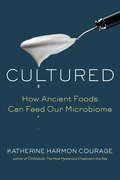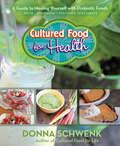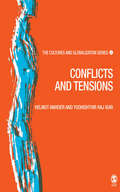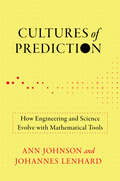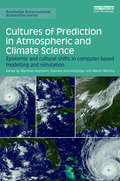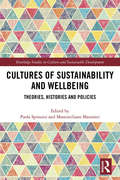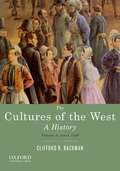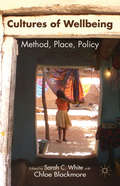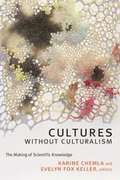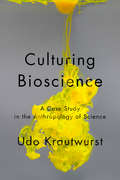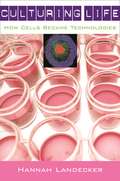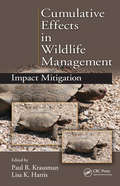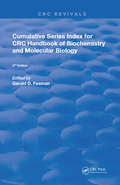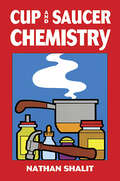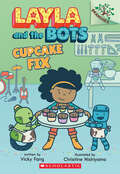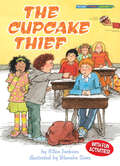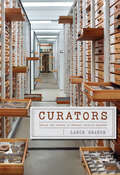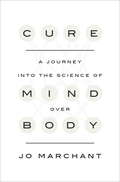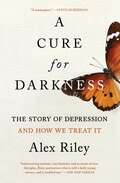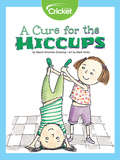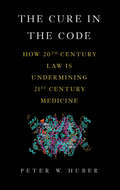- Table View
- List View
Cultured: How Ancient Foods Can Feed Our Microbiome
by Katherine Harmon CourageA revealing look at the 300 trillion microorganisms that keep us healthy—and the foods they need to thrive These days, probiotic yogurt and other "gut-friendly" foods line supermarket shelves. But what's the best way to feed our all-important microbiome—and what is a microbiome, anyway? In this engaging and eye-opening book, science journalist Katherine Harmon Courage investigates these questions, presenting a deep dive into the ancient food traditions and the latest research for maintaining a healthy gut. Courage’s insights include: • Meet your microbiome: What it is, how it works, and why it's essential for our immune system--and overall health • Gut-friendly food traditions: A guided tour of artisanal makers of yogurt, kimchi, kefir, kombucha, olives, cocoa, and other vibrant, ancient foods from around the world that feed our microbiome (along with simple recipes for curious at-home cooks) • Cutting-edge science: A first-hand look at some of the top lab facilities where microbiologists are working to better understand the human gut and how to feed it for good health Equal parts science explainer, culinary investigation, and global roadmap for healthy eating, Cultured offers a wealth of information for anyone interested in making smart food choices in our not-so-gut-friendly modern world.
Cultured Food for Health: A Guide To Healing Yourself With Probiotic Foods Kefir * Kombucha * Cultured Vegetables
by Donna SchwenkIf youre having digestive problems or feeling sick and rundownor if you simply want to feel better and have more energythis is the book for you. In Cultured Food for Health, Donna Schwenk opens your eyes to the amazing healing potential of cultured foods. Focusing on the notion that all disease begins in the guta claim made by Hippocrates, the father of medicine, more than 2000 years agoshe brings together cutting-edge research, firsthand accounts from her online community, and her personal healing story to highlight the links between an imbalanced microbiome and a host of ailments, including high blood pressure, allergies, depression, autism, IBS, and so many more.Then she puts the power in your hands, teaching you how to bring three potent probiotic foodskefir, kombucha, and cultured vegetablesinto your diet. Following the advice in these pages, along with her 21-day program, you can easily (and deliciously!) flood your system with billions of good bacteria, which will balance your body and allow it to heal naturally.In this book, youll find:*;Step-by-step instructions on how to make basic kefir, kombucha, and cultured vegetables*;More than 100 tasty, easy-to-make recipes, from smoothies to desserts, that feature probiotic foods*;A three-week program with day-by-day instructions on gathering supplies and ingredients, and making and eating cultured foods*;Helpful answers to some of the most frequently asked questions about culturing*;Hints and tips about how to easily incorporate cultured foods into your life*;Exciting information on the probiotic-enhancing properties of prebiotic foods, such as apples, broccoli, onions, squash, brussels sprouts, and honey
Cultured Food for Life: How To Make And Serve Delicious Probiotic Foods For Better Health And Wellness
by Donna SchwenkDonna Schwenk's world changed when she discovered cultured foods. After a difficult pregnancy and various health problems, she became determined to find answers to what ailed her. And in her quest, she came across the ancient art of home fermentation, a food preparation technique that supercharges everyday foods with beneficial bacteria to balance your digestive system, and vitamins and minerals to enhance your overall health. This simple, natural process has been used for thousands of years to create everything from drinks like kefir and kombucha to foods like kimchi and pickles. After incorporating fermented foods into her life, Donna began to experience a vitality that she had never known. And then she was hooked! She started a new life as a teacher and writer, blogging on her website culturedfoodlife.com, in an effort to bring the beautiful world of fermented foods to as many people as possible. She now works with thousands of people to open the door to a world of foods that can help improve an array of health problems including high blood pressure, diabetes, allergies, acne, hypertension, asthma, and irritable bowel syndrome. In Cultured Food for Life Donna brings this same information to you and shows you that preparing and eating cultured foods is easy, fun, and delicious! After speaking to the science behind the healing power of probiotic foods and telling the astonishing story of how she healed herself and her family, Schwenk walks you, step by step, through the basic preparation techniques for kefir, kombucha, cultured vegetables, and sprouted flour, plus more than 135 recipes that use these foods to create dishes to please any palate. With recipes like Herbed Omelet with Kefir Hollandaise Sauce,Sprouted Ginger Scones with Peaches and Kefir Cream,Kefir Veggie Sprouted Pizza, Apple Sauerkraut, and Brownie Cupcakes with Kefir Frosting, along with inspirational stories from Donna's family and friends, you'll learn everything you want to know about a diet that's as tasty as it is healthy.
Cultures and Globalization: Conflicts and Tensions (The Cultures and Globalization Series)
by Helmut K. Anheier Yudhishthir Raj IsarThe world's cultures and their forms of creation, presentation, and preservation are deeply affected by globalization in ways that are inadequately documented and understood. The Cultures and Globalization Series is designed to fill this void in our knowledge.<P> Analyzing the relationship between globalization and cultures is the aim of the Series. In each volume, leading experts as well as young scholars will track cultural trends connected to globalization throughout the world, covering issues ranging from the role of cultural difference in politics and governance to the evolution of the cultural economy and the changing patterns of creativity and artistic expression. Each volume will also include an innovative presentation of newly developed 'indicator suites' on cultures and globalization that will be presented in a user-friendly form with a high graphics content to facilitate accessibility and understanding.<P> The inaugural theme is 'Conflicts and Tensions': the cultural dimensions of conflict and the conflictual dimensions of culture. Like so many phenomena linked to globalization, conflicts over and within the cultural realms crystallize great anxieties and illusions, through misplaced assumptions, inadequate concepts, unwarranted simplifications and instrumental readings. The aim here is to marshal evidence from different disciplines and perspectives about the culture, conflict and globalization relationships in conceptually sensitive ways. Thus, in a broad and genuine sense, the Cultures and Globalization Series means not only to promote better understanding of contemporary cultural change but also to serve the cause of peace and security through informed, open and diversified debate.
Cultures of Computation and Quantification in the Ancient World: Numbers, Measurements, and Operations in Documents from Mesopotamia, China and South Asia (Why the Sciences of the Ancient World Matter #6)
by Karine Chemla Agathe Keller Christine ProustThis book sheds light on the variety of mathematical cultures in general. To do so, it concentrates on cultures of computation and quantification in the ancient world, mainly in ancient China, South Asia, and the Ancient Near East and offers case studies focused on numbers, quantities, and operations, in particular in relation to mathematics as well as administrative and economic activities. The various chapters focus on the different ways and contexts of shaping numbers and quantities, and on the procedures applied to them. The book places special emphasis on the processes of emergence of place-value number systems, evidenced in the three geographical areas under study All these features yield essential elements that will enable historians of mathematics to further capture the diversity of computation practices in their contexts, whereas previous historical approaches have tended to emphasize elements that displayed uniformity within “civilizational” blocks. The book includes editions and translations of texts, some of them published here for the first time, maps, and conventions for editions of ancient texts. It thereby offers primary sources and methodological tools for teaching and learning. The volume is aimed at historians and philosophers of science and mathematics, historians of the ancient worlds, historians of economics, sinologists, indologists, assyriologists, as well as undergraduate, graduate students and teachers in mathematics, the history and philosophy of science and mathematics, and in the history of ancient worlds.
Cultures of Mass Tourism: Doing the Mediterranean in the Age of Banal Mobilities (New Directions in Tourism Analysis)
by Pau Obrador PonsWith more than 230 million international tourists a year, the Mediterranean region is the largest tourist destination in the world. This book outlines that its economic importance is matched by its significance as a cultural and aesthetic phenomenon. Through a series of ethnographic insights into some of the key sites of mass Mediterranean tourism, it focuses on package tourists' experiences of the serial, banal and depthless spaces that are mushrooming along the coast and the enchantments, dissolutions and dreams that saturate them. Moving away from the notion of authentic places corrupted by mass tourism, the book shows how new forms and spaces are made and remade by the mobilities and performances of locals, workers and tourists. Finally, the book looks at the complex materialities of mass tourism and the many networks that make it possible.
Cultures of Prediction: How Engineering and Science Evolve with Mathematical Tools (Engineering Studies)
by Ann Johnson Johannes LenhardA probing examination of the dynamic history of predictive methods and values in science and engineering that helps us better understand today&’s cultures of prediction.The ability to make reliable predictions based on robust and replicable methods is a defining feature of the scientific endeavor, allowing engineers to determine whether a building will stand up or where a cannonball will strike. Cultures of Prediction, which bridges history and philosophy, uncovers the dynamic history of prediction in science and engineering over four centuries. Ann Johnson and Johannes Lenhard identify four different cultures, or modes, of prediction in the history of science and engineering: rational, empirical, iterative-numerical, and exploratory-iterative. They show how all four develop together and interact with one another while emphasizing that mathematization is not a single unitary process but one that has taken many forms.The story is not one of the triumph of abstract mathematics or technology but of how different modes of prediction, complementary concepts of mathematization, and technology coevolved, building what the authors call &“cultures of prediction.&” The first part of the book examines prediction from early modernity up to the computer age. The second part probes computer-related cultures of prediction, which focus on making things and testing their performance, often in computer simulations. This new orientation challenges basic tenets of the philosophy of science, in which scientific theories and models are predominantly seen as explanatory rather than predictive. It also influences the types of research projects that scientists and engineers undertake, as well as which ones receive support from funding agencies.
Cultures of Prediction in Atmospheric and Climate Science: Epistemic and Cultural Shifts in Computer-based Modelling and Simulation (Routledge Environmental Humanities)
by Matthias Heymann Gabriele Gramelsberger Martin MahonyIn recent decades, science has experienced a revolutionary shift. The development and extensive application of computer modelling and simulation has transformed the knowledge‐making practices of scientific fields as diverse as astro‐physics, genetics, robotics and demography. This epistemic transformation has brought with it a simultaneous heightening of political relevance and a renewal of international policy agendas, raising crucial questions about the nature and application of simulation knowledges throughout public policy. Through a diverse range of case studies, spanning over a century of theoretical and practical developments in the atmospheric and environmental sciences, this book argues that computer modelling and simulation have substantially changed scientific and cultural practices and shaped the emergence of novel ‘cultures of prediction’. Making an innovative, interdisciplinary contribution to understanding the impact of computer modelling on research practice, institutional configurations and broader cultures, this volume will be essential reading for anyone interested in the past, present and future of climate change and the environmental sciences.
Cultures of Sustainability and Wellbeing: Theories, Histories and Policies (Routledge Studies in Culture and Sustainable Development)
by Paola Spinozzi Massimiliano MazzantiCultures of Sustainability and Wellbeing: Theories, Histories and Policies examines and assesses the interdependence between sustainability and wellbeing by drawing attention to humans as producers and consumers in a post-human age. Why wellbeing ought to be regarded as essential to sustainable development is explored first from multifocal theoretical perspectives encompassing sociology, literary criticism and socioeconomics, second in relation to institutions and policies, and third with a focus on specific case studies across the world. Wellbeing and its sustainability are defined in terms of biological and cultural diversity; stages of advancement in science and technology; notions of citizenship and agency; geopolitical scenarios and environmental conditions. Wellbeing and sustainability call for enquiries into human capacities in ontological, epistemological and practical terms. A view of sustainability that revolves around material and immaterial wellbeing is based on the assumption that life quality, comfort, happiness, security, safety always posit humans as both recipients and agents. Risk and resilience in contemporary societies define the intrinsically human ability to make and consume, to act and adapt, driving the search for and fruition of wellbeing. How to sustain the dual process of exploitation and regeneration is a task that requires integrated approaches from the sciences and the humanities, jointly tracing a worldwide cartography with clear localisations. This book will be of great interest to students and researchers interested in sustainability through conceptual and empirical approaches including social theory, literary and cultural studies, environmental economics and human ecology, urbanism and cultural geography.
Cultures of the West: Since 1350
by Clifford R. BackmanThe book highlights on the ways in which the major ideas like religion, science, and philosophy and passions of Western culture developed, internally, and how they interacted with the rest of the world.
Cultures of Wellbeing: Method, Place, Policy
by Sarah C. White Chloe BlackmoreThe authors challenge psychological perspectives on happiness and subjective wellbeing. Highlighting the politics of quantitative and qualitative methodologies, case studies across continents explore wellbeing in relation to health, children and youth, migration, economics, religion, family, land mines, national surveys, and indigenous identities.
Cultures without Culturalism: The Making of Scientific Knowledge
by Evelyn Fox Keller Karine ChemlaCultural accounts of scientific ideas and practices have increasingly come to be welcomed as a corrective to previous—and still widely held—theories of scientific knowledge and practices as universal. The editors caution, however, against the temptation to overgeneralize the work of culture, and to lapse into a kind of essentialism that flattens the range and variety of scientific work. The book refers to this tendency as culturalism. The contributors to the volume model a new path where historicized and cultural accounts of scientific practice retain their specificity and complexity without falling into the traps of culturalism. They examine, among other issues, the potential of using notions of culture to study behavior in financial markets; the ideology, organization, and practice of earthquake monitoring and prediction during China's Cultural Revolution; the history of quadratic equations in China; and how studying the "glass ceiling" and employment discrimination became accepted in the social sciences. Demonstrating the need to understand the work of culture as a fluid and dynamic process that directly both shapes and is shaped by scientific practice, Cultures without Culturalism makes an important intervention in science studies. Contributors. Bruno Belhoste, Karine Chemla, Caroline Ehrhardt, Fa-ti Fan, Evelyn Fox Keller, Kenji Ito, Guillaume Lachenal, Donald MacKenzie, Mary Morgan, Nancy Nersessian, David Rabouin, Hans-Jörg Rheinberger, Claude Rosental, Koen Vermeir
Culturing Bioscience: A Case Study In The Anthropology Of Science (Teaching Culture: Utp Ethnographies For The Classroom Ser.)
by Udo KrautwurstCharting the rise and fall of an experimental biomedical facility at a North American university, Culturing Bioscience offers a fascinating glimpse into scientific culture and the social and political context in which that culture operates. Krautwurst nests the discussion of scientific culture within a series of levels from the lab to the global political economy. In the process he explores a number of topics, including: the social impact of technology; researchers' relationships with sophisticated equipment; what scientists actually do in a laboratory; what role science plays in the contemporary university; and the way bioscience interacts with local, regional, and global governments. The result is a rich case study that illustrates a host of contemporary issues in the social study of science.
Culturing Life: How Cells Became Technologies
by Hannah LandeckerHow did cells make the journey, one we take so much for granted, from their origin in living bodies to something that can be grown and manipulated on artificial media in the laboratory, a substantial biomass living outside a human body, plant, or animal? This is the question at the heart of Hannah Landecker's book. She shows how cell culture changed the way we think about such central questions of the human condition as individuality, hybridity, and even immortality and asks what it means that we can remove cells from the spatial and temporal constraints of the body and "harness them to human intention." Rather than focus on single discrete biotechnologies and their stories--embryonic stem cells, transgenic animals--Landecker documents and explores the wider genre of technique behind artificial forms of cellular life. She traces the lab culture common to all those stories, asking where it came from and what it means to our understanding of life, technology, and the increasingly blurry boundary between them. The technical culture of cells has transformed the meaning of the term "biological," as life becomes disembodied, distributed widely in space and time. Once we have a more specific grasp on how altering biology changes what it is to be biological, Landecker argues, we may be more prepared to answer the social questions that biotechnology is raising.
Cumulative Effects in Wildlife Management: Impact Mitigation
by Paul R. Krausman Lisa K. HarrisAs humans continue to encroach on wildlands, quality and quantity of wildlife habitat decreases before our eyes. A housing development here, a shopping mall there, a few more trees cut here, another road put in there, each of these diminishes available habitat. Unless the cumulative effects of multiple simultaneous development projects are recogniz
Cumulative Series Index for CRC Handbook of Biochemistry and Molecular Biology: 3rd Edition (Routledge Revivals)
by Gerald D. FasmanFirst Published in 1977, this book serves as a directory for the handbook of biochemistry and molecular biology.
Cup and Saucer Chemistry (Dover Children's Science Books)
by Nathan ShalitWritten by an award-winning author of science books for children, this engrossing book enables youngsters (ages 7 to 13) to do 38 safe experiments at home or in the classroom with such common items as a teaspoon and saucer, paper towels, aspirin, baking powder, plastic straws, vinegar, and rubbing alcohol.The language of the text is clear enough for grade-school children yet is consistently (and technically) accurate and informative. Directions for simple experiments describe how to write "invisible messages" with home-made phenolphthalein, how to clean pennies with salt and vinegar, how to break aspirin into its components and how to perform a variety of other experiments involving carbonates and acids, precipitates, crystals, emulsions, catalysts, hydrogen, copper plating, chemical indicators, color flame tests, and much more.Easy-to-follow instructions, accompanied by abundant and clearly detailed illustrations, distinguish a book which not only provides children with fun-filled scientific challenges, but also serves as a valuable aid to parents, teachers, and other adults working with youngsters interested in science.
Cupcake Fix: A Branches Book (Layla and the Bots #3)
by Vicky FangLayla and the Bots are building a SWEET new invention!Pick a book. Grow a Reader!This series is part of Scholastic's early chapter book line Branches, aimed at newly independent readers. With easy-to-read text, high-interest content, fast-paced plots, and illustrations on every page, these books will boost reading confidence and stamina. Branches books help readers grow!Blossom Valley is opening a new community center! But they need to generate buzz for the grand opening. Layla and the Bots know how to help: they will build a cupcake machine for the party! But will their invention be a piece of cake... or a recipe for disaster? With full-color artwork on every page, speech bubbles throughout, and a fun DIY activity that readers can try at home, this early chapter book series brings kid-friendly STEAM topics to young readers!
The Cupcake Thief: Justice System (Social Studies Connects)
by Ellen JacksonThe popular Social Studies Connects series links history, geography, civics and economics to kids&’ daily lives. Featuring stories with diverse characters who face situations young readers can relate to, these books support reading and social studies skills including researching, inferring, comparing, and communication. An activity to stimulate curiosity about the world is included in each book!Zack's cupcake went missing, and someone ate the evidence. Is Tyler innocent--or guilty? Only the Student Court can decide! (Social Studies Topic: Civics/Justice System)
Curators: Behind the Scenes of Natural History Museums
by Lance GrandeOver the centuries, natural history museums have evolved from being little more than musty repositories of stuffed animals and pinned bugs, to being crucial generators of new scientific knowledge. They have also become vibrant educational centers, full of engaging exhibits that share those discoveries with students and an enthusiastic general public. At the heart of it all from the very start have been curators. Yet after three decades as a natural history curator, Lance Grande found that he still had to explain to people what he does. This book is the answer—and, oh, what an answer it is: lively, exciting, up-to-date, it offers a portrait of curators and their research like none we’ve seen, one that conveys the intellectual excitement and the educational and social value of curation. Grande uses the personal story of his own career—most of it spent at Chicago’s storied Field Museum—to structure his account as he explores the value of research and collections, the importance of public engagement, changing ecological and ethical considerations, and the impact of rapidly improving technology. Throughout, we are guided by Grande’s keen sense of mission, of a job where the why is always as important as the what. This beautifully written and richly illustrated book is a clear-eyed but loving account of natural history museums, their curators, and their ever-expanding roles in the twenty-first century.
Cure
by Jo Marchant<P>A rigorous, skeptical, deeply reported look at the new science behind the mind's extraordinary ability to heal the body. <P>Have you ever felt a surge of adrenaline after narrowly avoiding an accident? Salivated at the sight (or thought) of a sour lemon? Felt turned on just from hearing your partner's voice? If so, then you've experienced how dramatically the workings of your mind can affect your body. <P>Yet while we accept that stress or anxiety can damage our health, the idea of "healing thoughts" was long ago hijacked by New Age gurus and spiritual healers. Recently, however, serious scientists from a range of fields have been uncovering evidence that our thoughts, emotions, and beliefs can ease pain, heal wounds, fend off infection and heart disease, even slow the progression of AIDS and some cancers. <P>In Cure, award-winning science writer Jo Marchant travels the world to meet the physicians, patients, and researchers on the cutting edge of this new world of medicine. We learn how meditation protects against depression and dementia, how social connections increase life expectancy, and how patients who feel cared for recover from surgery faster. <P>We meet Iraq war veterans who are using a virtual arctic world to treat their burns and children whose ADHD is kept under control with half the normal dose of medication. We watch as a transplant patient uses the smell of lavender to calm his hostile immune system and an Olympic runner shaves vital seconds off his time through mind-power alone. <P>Drawing on the very latest research, Marchant explores the vast potential of the mind's ability to heal, acknowledges its limitations, and explains how we can make use of the findings in our own lives. <P><b>A New York Times Bestseller</b>
Cure: A Journey into the Science of Mind Over Body
by Jo MarchantA New York Times BestsellerFinalist for the Royal Society Insight Investment Science Book PrizeA rigorous, skeptical, deeply reported look at the new science behind the mind's surprising ability to heal the bodyHave you ever felt a surge of adrenaline after narrowly avoiding an accident? Salivated at the sight (or thought) of a sour lemon? Felt turned on just from hearing your partner's voice? If so, then you've experienced how dramatically the workings of your mind can affect your body. Yet while we accept that stress or anxiety can damage our health, the idea of "healing thoughts" was long ago hijacked by New Age gurus and spiritual healers. Recently, however, serious scientists from a range of fields have been uncovering evidence that our thoughts, emotions and beliefs can ease pain, heal wounds, fend off infection and heart disease and even slow the progression of AIDS and some cancers. In Cure, award-winning science writer Jo Marchant travels the world to meet the physicians, patients and researchers on the cutting edge of this new world of medicine. We learn how meditation protects against depression and dementia, how social connections increase life expectancy and how patients who feel cared for recover from surgery faster. We meet Iraq war veterans who are using a virtual arctic world to treat their burns and children whose ADHD is kept under control with half the normal dose of medication. We watch as a transplant patient uses the smell of lavender to calm his hostile immune system and an Olympic runner shaves vital seconds off his time through mind-power alone. Drawing on the very latest research, Marchant explores the vast potential of the mind's ability to heal, lays out its limitations and explains how we can make use of the findings in our own lives. With clarity and compassion, Cure points the way towards a system of medicine that treats us not simply as bodies but as human beings.From the Hardcover edition.
A Cure for Darkness: The Story of Depression and How We Treat It
by Alex RileyA fascinating look at the treatment of depression, blending journalism, science, history, and memoir, by an award-winning science writer.What is depression? Is it a persistent low mood or a complex range of symptoms? Is it a single diagnosis or a diversity of mental disorders requiring different treatments? In A Cure for Darkness, science writer Alex Riley explores these questions, digging into the long history of depression and chronicling the lives of psychiatrists and scientists who sought cures for their patients. Since 2015, Riley has received both cognitive behavioral therapy and antidepressants for his own depression. Throughout his treatment, he wondered—are antidepressants effective? Do short-term talking therapies actually work? And what treatments are on the horizon for those who don&’t respond to these first-line treatments? Expanding from his own experience, he tracks treatments through history, from the &“talking cure&” to electroconvulsive therapy to magic mushrooms. With depression fast becoming the leading burden of disease around the world, the future of mental healthcare depends not just on the development of new therapies, but on increasing access for people who are currently without. Reporting on the field of global mental health from its colonial past to the present day, Riley highlights a range of scalable therapies, including how a group of grandmothers stands on the frontline of a mental health revolution. Weaving in personal and family history, A Cure for Darkness is a gripping narrative journey and a surprisingly hopeful work that delves deep into the science of mental health.
A Cure for the Hiccups
by Naomi Kinsman DowningHave you ever had the hiccups? Amber and her sister want to find a cure! After multiple attempts, though, they still haven’t figured one out. Learn about why we get the hiccups and whether or not there’s a cure!
The Cure in the Code: How 20th Century Law is Undermining 21st Century Medicine
by Peter W. HuberNever before have two revolutions with so much potential to save and prolong human life occurred simultaneously. The converging, synergistic power of the biochemical and digital revolutions now allows us to read every letter of life's code, create precisely targeted drugs to control it, and tailor their use to individual patients. Cancer, diabetes, Alzheimer's and countless other killers can be vanquished-if we make full use of the tools of modern drug design and allow doctors the use of modern data gathering and analytical tools when prescribing drugs to their patients.But Washington stands in the way, clinging to outdated drug-approval protocols developed decades ago during medicine's long battle with the infectious epidemics of the past. Peter Huber, an expert in science, technology, and public policy, demonstrates why Washington's one-size-fits-all drug policies can't deal with diseases rooted in the complex molecular diversity of human bodies. Washington is ill-equipped to handle the torrents of data that now propel the advance of molecular medicine and is reluctant to embrace the statistical methods of the digital age that can. Obsolete economic policies, often rationalized as cost-saving measures, stifle innovation and suppress investment in the medicine that can provide the best cures at the lowest cost.In the 1980s, an AIDS diagnosis was a death sentence, until the FDA loosened its throttling grip and began streamlining and accelerating approval of life-saving drugs. The Cure in the Code shows patients, doctors, investors, and policy makers what we must now do to capture the full life-saving and cost-saving potential of the revolution in molecular medicine. America has to choose. At stake for America is the power to lead the world in mastering the most free, fecund, competitive, dynamic, and intelligent natural resource on the planet-the molecular code that spawns human life and controls our health.
